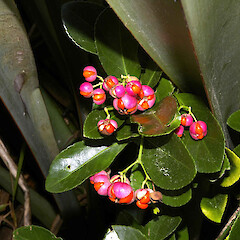Euonymus japonicus
Common name
Japanese spindleberry
Family
Celastraceae
Flora category
Vascular – Exotic
Structural class
Trees & Shrubs - Dicotyledons
NVS code
The National Vegetation Survey (NVS) Databank is a physical archive and electronic databank containing records of over 94,000 vegetation survey plots - including data from over 19,000 permanent plots. NVS maintains a standard set of species code abbreviations that correspond to standard scientific plant names from the Ngä Tipu o Aotearoa - New Zealand Plants database.
EUOJAP
Conservation status
Not applicable
Habitat
Terrestrial.
Detailed description
Much branched evergreen shrub or small tree up to 7m high. Twigs green, terete or slightly 4-ribbed, smooth, often wrinkled when dry, not winged. Leaves opposite, obovate to elliptic, acute, crenate, 2.5~7cm long; petiole 5~15mm long. Cymes 5, many-flowered, pedunculate, dichotomous. Buds greenish, slightly 4-angled; flowers 4-merous, 6~10mm diam.; petals green, broadly elliptic, widely separated. Capsule globose, 4-celled, pink, 6~10mm diam., exposing orange to deep red aril after opening. (- Webb et al., 1988)
Similar taxa
Much branched evergreen shrub or small tree up to 7m high; twigs green, smooth, often wrinkled when dry; leaves opposite 2.5-7cm long; buds greenish; petals green; fruit capsule pink, 6-10mm diameter, exposes orange to deep red seed appendages after opening (Webb et al., 1988).
Flowering
November, December
Flower colours
Green, White
Fruiting
March, April, May
Year naturalised
1980
Origin
Japan, China, Korea
Etymology
euonymus: One possible explanation is this genus is named after Euonyme, the mother of the Furies (vengeance deities in Greek mythology) because of the irritating properties of this plant. Another explanation is that the name is simply from the Greek eu ‘good’ and onoma ‘name’, meaning ‘a name of good repute’.
japonicus: From Japan
National Pest Plant Accord species
This plant is listed in the 2020 National Pest Plant Accord. The National Pest Plant Accord (NPPA) is an agreement to prevent the sale and/or distribution of specified pest plants where either formal or casual horticultural trade is the most significant way of spreading the plant in New Zealand. For up to date information and an electronic copy of the 2020 Pest Plant Accord manual (including plant information and images) visit the MPI website.
Reason For Introduction
Ornamental
Life Cycle Comments
Perennial.
Poisonous plant:
The spindle berries and orange coated seeds are poisonous.



